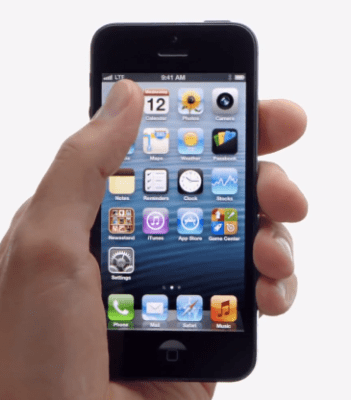“iPhone 5 offers a new 4 inch retina display, which is the most advanced display in the industry,” said Tim Cook. “No one comes close to matching the quality of the Retina Display.”
He is, of course, obligated to both say and believe this despite the fact there are plenty of displays already available and forthcoming that surpass the iPhone 5’s Retina display.
Now, when we’re talking about size, there are various schools of thought on what works best. But Apple has stayed strong with the 4-inch iPhone 5’s one-handed usability, after years of refusing to budge from the 3.5-inch screen size.
“We put a lot of thinking into screen size and think we’ve picked the right one,” said the CEO. Cook explained that the iPhone 5 managed to offer a larger Apple-flavored display “without sacrificing the one-handed ease of use that our customers love.”
It’s true enough, to him at least, for Apple to put out a whole commercial on it. It’s called Thumb. It’s cute.
But with all due respect: To think that the iPhone 5 (like the iPhone 4 of yester-year) has the best display on the market is a little naive.
Since size is based entirely on opinion, there’s no need to delve into that. But when it comes to pixel density and display technology, a 326ppi LCD screen doesn’t really compete with the brand new stuff coming out of the Android pen. Consider the 5-inch 1080p SLCD3 display on the Droid DNA, with 440ppi. It’s already available, and getting rave reviews.
Then there’s the Xperia Z, from Sony. It hasn’t been released yet, so we haven’t played with it extensively, but some hands-on time at CES proves that Sony, too, is capable of a stunning 1080p 5-inch display, topping out at 440ppi. The LG Optimus G Pro, not yet announced, is also said to have a 5-inch 1080p display.
But HTC, LG, and Sony aren’t primary concerns for Apple. Samsung, on the other hand, is one to watch, and the latest rumors suggest the Korean firm’s flagship Galaxy S IV will have a 5-inch 440 ppi display, too. And that one will feature Samsung’s premium Super AMOLED screen.
Regardless of competition, though, the question is whether or not Apple will push along with everyone else and bump up size and/or pixel density in the coming generations of the iPhone. Jobs explained with the iPhone 4 that the Retina display’s 326ppi was dense enough to eliminate pixel differentiation to the human eye.
This statement has been rebuked quite a bit since then, and the fact that manufacturers are racing to pack in the pixels only validates the fact that Jobs’ fact was more of a marketing fact than a science fact.
